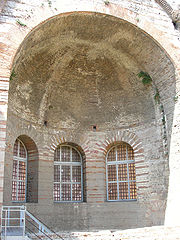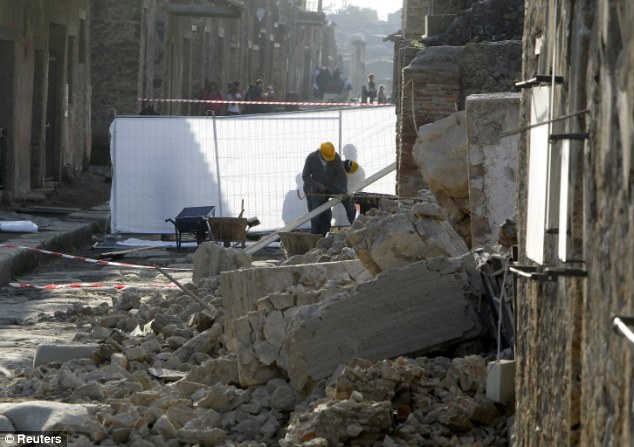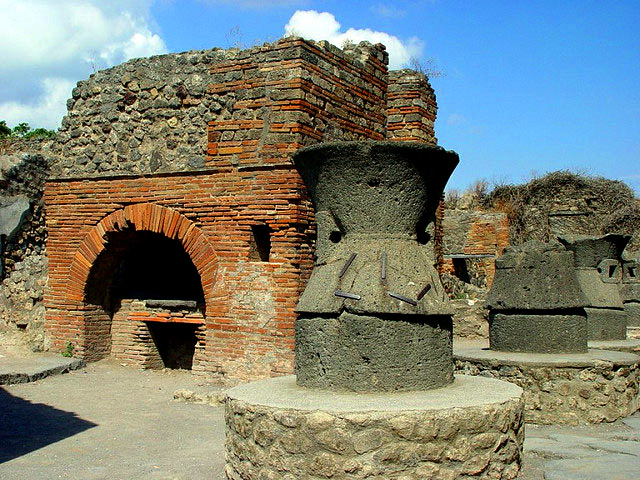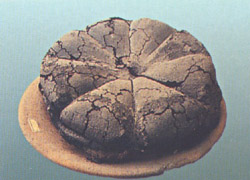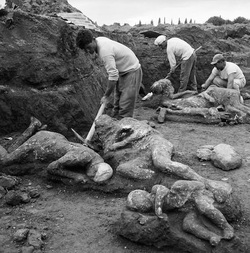Good evening, its two cities were buried by the vesuve in 79 after jesus christ they are the witnesses of the daily life that we can relive by crossing the streets and the people who lived there formerly.
I will show you the reconstitution of this woman who died in Herculaneum (in 79 she had taken refuge in the boat shelter she died under a heat between 400 and 500 ° C, Voiçi Bella Donna
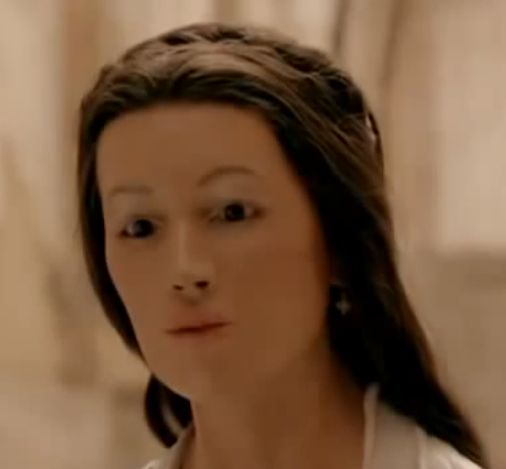
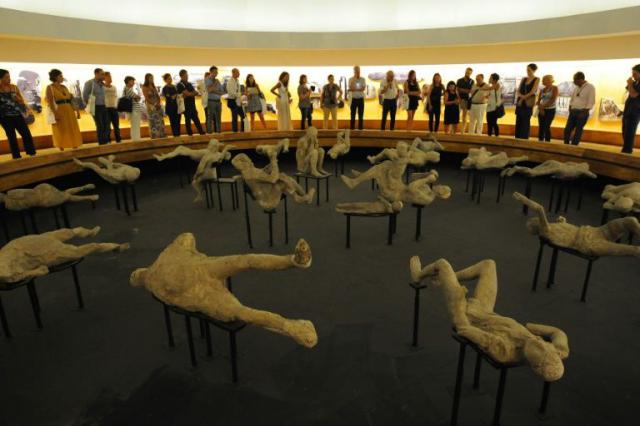
Visitors watch the casts of the bodies of the victims of the eruption of Pompeii, on the archaeological site under renovation, August 5, 2015
The archaeological site of Pompeii, buried in 79 AD and become one of the most precious testimonies of the past in the world, is preparing to be reborn for the second time, a challenge for Italy and archaeologists.
"I have never seen such dynamism. Thousands of people are working now, we have 35 projects under way," explains the superintendent in charge of Pompeii Massimo Osanna, enthusiastically, during an interview in The AFP.
This training archaeologist was appointed two years ago, in full controversy over the maintenance conditions of the immense site where landslides, collapses, small larcenies and vast mafia plunder.
It now manages an envelope of 130 million euros, including 96 million European funds, for the conservation and renovation of Pompeii.
This "Great Project" Pompeii has the support of the government: "we will have the resources, we will continue to work", he assures, while Unesco, which had a long time threatened to withdraw Pompeii from its heritage list World of humanity due to the dilapidated state of the site, recognized in March a real change of course.
The ancient Roman city, frozen in time by the ashes of Mount Vesuvius on August 24, 79, is the second tourist site of the country behind the Coliseum in Rome, with 2.7 million visitors in 2014.
It has become a metaphor for Italy: beautiful because of its immense artistic heritage, but impossible as it is difficult to maintain and enhance this heritage.
- 'The wind has turned' -
"The wind has turned in Pompeii and the results are there," said Italian Culture Minister Dario Franceschini this week at the inauguration of the "Grand Gymnasium" after seven years of restoration, where young citizens Of the city came to do sport before the volcanic eruption.
POMPEII
The origins of Pompeii are as ancient as those of Rome. The Pompeians were descended from one of the first Italic peoples: the Oschi.
Towards the middle of the seventh century BC, probably the first settlements, perhaps a small hamlet around a communication node at the crossroads of three important roads, between Cumae, Nola and Stabia.
Pompeii, a compulsory passage between the north and the south, quickly became a prey for the powerful neighboring states.
The first certain traces of a settlement date back to the 6th century BC.
It was first conquered by the Greek colony of Cumae between 525 and 474 BC.

Strabo relates that Pompeii was conquered by the Etruscans. Information, which in light of recent excavations is becoming more and more credible. Indeed, in the area of the temple of Apollo and near the Thermal Stabiane have been found many fragments of "bucchero", some even with Etruscan engraved inscriptions. In addition, still in the Thermes area, a necropolis of the 6th century was discovered.
Towards the middle of the fifth century BC, the Etruscans lose a naval battle in the waters against Cumae against the Cumans allied with the Syracusans, Pompeii then passes under Greek hegemony.
It is probably from this period that the enclosure dates with its tufa walls which surrounded more than sixty hectares, even if the city itself did not exceed ten hectares ...
In the 4th century, Pompeii was involved in the Sannite Wars, at the end of which Rome remained the undisputed mistress of all Campania, and the city retained a linguistic and institutional autonomy.
It was in the 4th century that the first regular urban plan of the city, which received about -300 new fortifications.

During the Second Punic War Pompeii remained faithful to Rome, unlike many other Campanian cities. In this way it was able to maintain its partial independence by joining forces with the victor.
In the 2nd century BC, the intensive cultivation of the land and the export of wine and oil enriched the city, whose standard of living became very high. To realize this, it is enough to note the wealth of some houses and their luxurious furnishings. The Casa del Fauno, for example, rivals in size (almost 3000 m²) with the most famous Greek royal residences.
At the outbreak of the Social War (91 BC) Pompeii was against Rome and allied with all the other towns of Campania in an attempt to obtain full Roman citizenship. But it was impossible to resist the military superiority of Rome: in 89 BC Sylla forced Stabia to capitulate, and turned to Pompeii, who attempted a valiant defense by strengthening the enclosure and with the aid of the Celts commanded by Clutentius. This attempt of resistance proved vain and the city fell quickly.

In 80 BC, Pompeii entered completely into the orbit of Rome and Sylla, which transferred a colony of veterans to it, calling it the Colony Cornelia Veneria Pompeianorum. The allocation of land to the veterans certainly occurred to the disadvantage of those who had been most bitterly opposed to Sylla. Political and military events, however, had little effect on the well-being and commerce of the Pompeians, who depended chiefly on the exportation of Campanian wines, often cultivated on remote lands.
For its climate and the facetiousness of the landscape, the city and its surroundings even constituted a pleasant place of holiday for some rich Romans, including Cicero who owned a house there. Unfortunately the sources are rather avaricious concerning the life of the Pompeians during the first imperial age. Only Tacitus recalls as a sensational fact the brawl between Nucerians and Pompeians which took place in 59 AD in the amphitheater of Pompeii, which urged Nero to prohibit for ten years any spectacle of gladiators.
In 62 AD the city was shaken by an earthquake: at the time of the eruption of AD 79 many buildings were still being reconstructed.

Pompeii (Pompeii in Latin), was a city of Campania in Italy located 25 km from Naples at the foot of Mount Vesuvius. Founded in the 6th century BC. In the year 79, it had about 20,000 inhabitants. That year, it was completely buried with Herculanum and Stabies, during a volcanic eruption of the volcano. The city, populated by merchants and artisans, was very flourishing.

Forgotten for 1,600 years, it was rediscovered by chance to become today one of the jewels of archeology and an extraordinary testimony of the Roman Empire.

I will show you the reconstitution of this woman who died in Herculaneum (in 79 she had taken refuge in the boat shelter she died under a heat between 400 and 500 ° C, Voiçi Bella Donna


Visitors watch the casts of the bodies of the victims of the eruption of Pompeii, on the archaeological site under renovation, August 5, 2015
The archaeological site of Pompeii, buried in 79 AD and become one of the most precious testimonies of the past in the world, is preparing to be reborn for the second time, a challenge for Italy and archaeologists.
"I have never seen such dynamism. Thousands of people are working now, we have 35 projects under way," explains the superintendent in charge of Pompeii Massimo Osanna, enthusiastically, during an interview in The AFP.
This training archaeologist was appointed two years ago, in full controversy over the maintenance conditions of the immense site where landslides, collapses, small larcenies and vast mafia plunder.
It now manages an envelope of 130 million euros, including 96 million European funds, for the conservation and renovation of Pompeii.
This "Great Project" Pompeii has the support of the government: "we will have the resources, we will continue to work", he assures, while Unesco, which had a long time threatened to withdraw Pompeii from its heritage list World of humanity due to the dilapidated state of the site, recognized in March a real change of course.
The ancient Roman city, frozen in time by the ashes of Mount Vesuvius on August 24, 79, is the second tourist site of the country behind the Coliseum in Rome, with 2.7 million visitors in 2014.
It has become a metaphor for Italy: beautiful because of its immense artistic heritage, but impossible as it is difficult to maintain and enhance this heritage.
- 'The wind has turned' -
"The wind has turned in Pompeii and the results are there," said Italian Culture Minister Dario Franceschini this week at the inauguration of the "Grand Gymnasium" after seven years of restoration, where young citizens Of the city came to do sport before the volcanic eruption.
POMPEII
The origins of Pompeii are as ancient as those of Rome. The Pompeians were descended from one of the first Italic peoples: the Oschi.
Towards the middle of the seventh century BC, probably the first settlements, perhaps a small hamlet around a communication node at the crossroads of three important roads, between Cumae, Nola and Stabia.
Pompeii, a compulsory passage between the north and the south, quickly became a prey for the powerful neighboring states.
The first certain traces of a settlement date back to the 6th century BC.
It was first conquered by the Greek colony of Cumae between 525 and 474 BC.

Strabo relates that Pompeii was conquered by the Etruscans. Information, which in light of recent excavations is becoming more and more credible. Indeed, in the area of the temple of Apollo and near the Thermal Stabiane have been found many fragments of "bucchero", some even with Etruscan engraved inscriptions. In addition, still in the Thermes area, a necropolis of the 6th century was discovered.
Towards the middle of the fifth century BC, the Etruscans lose a naval battle in the waters against Cumae against the Cumans allied with the Syracusans, Pompeii then passes under Greek hegemony.
It is probably from this period that the enclosure dates with its tufa walls which surrounded more than sixty hectares, even if the city itself did not exceed ten hectares ...
In the 4th century, Pompeii was involved in the Sannite Wars, at the end of which Rome remained the undisputed mistress of all Campania, and the city retained a linguistic and institutional autonomy.
It was in the 4th century that the first regular urban plan of the city, which received about -300 new fortifications.

During the Second Punic War Pompeii remained faithful to Rome, unlike many other Campanian cities. In this way it was able to maintain its partial independence by joining forces with the victor.
In the 2nd century BC, the intensive cultivation of the land and the export of wine and oil enriched the city, whose standard of living became very high. To realize this, it is enough to note the wealth of some houses and their luxurious furnishings. The Casa del Fauno, for example, rivals in size (almost 3000 m²) with the most famous Greek royal residences.
At the outbreak of the Social War (91 BC) Pompeii was against Rome and allied with all the other towns of Campania in an attempt to obtain full Roman citizenship. But it was impossible to resist the military superiority of Rome: in 89 BC Sylla forced Stabia to capitulate, and turned to Pompeii, who attempted a valiant defense by strengthening the enclosure and with the aid of the Celts commanded by Clutentius. This attempt of resistance proved vain and the city fell quickly.

In 80 BC, Pompeii entered completely into the orbit of Rome and Sylla, which transferred a colony of veterans to it, calling it the Colony Cornelia Veneria Pompeianorum. The allocation of land to the veterans certainly occurred to the disadvantage of those who had been most bitterly opposed to Sylla. Political and military events, however, had little effect on the well-being and commerce of the Pompeians, who depended chiefly on the exportation of Campanian wines, often cultivated on remote lands.
For its climate and the facetiousness of the landscape, the city and its surroundings even constituted a pleasant place of holiday for some rich Romans, including Cicero who owned a house there. Unfortunately the sources are rather avaricious concerning the life of the Pompeians during the first imperial age. Only Tacitus recalls as a sensational fact the brawl between Nucerians and Pompeians which took place in 59 AD in the amphitheater of Pompeii, which urged Nero to prohibit for ten years any spectacle of gladiators.
In 62 AD the city was shaken by an earthquake: at the time of the eruption of AD 79 many buildings were still being reconstructed.

Pompeii (Pompeii in Latin), was a city of Campania in Italy located 25 km from Naples at the foot of Mount Vesuvius. Founded in the 6th century BC. In the year 79, it had about 20,000 inhabitants. That year, it was completely buried with Herculanum and Stabies, during a volcanic eruption of the volcano. The city, populated by merchants and artisans, was very flourishing.

Forgotten for 1,600 years, it was rediscovered by chance to become today one of the jewels of archeology and an extraordinary testimony of the Roman Empire.




